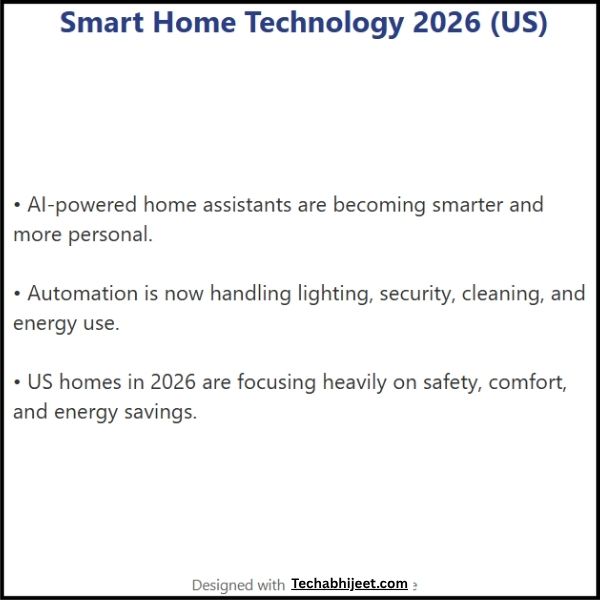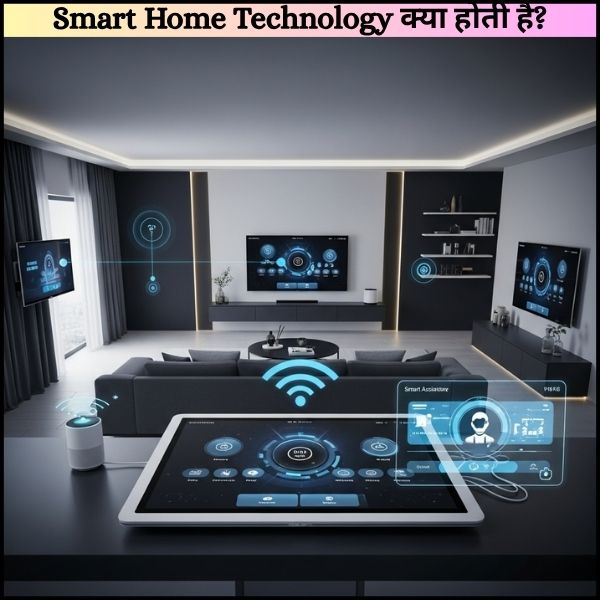1. Introduction: Smart Homes Are Not the Future Anymore… They’re Already Here
So, picture this. You walk into your home after a long workday, your front door unlocks itself, the lights fade in like a movie scene, the thermostat shifts to your comfort zone, and the speakers whisper your favorite chill playlist.
This isn’t sci-fi anymore. This is literally Smart Home Technology 2026 in US.
And honestly, the way things are moving, smart homes are becoming as normal as having Wi-Fi in the house. In 2026, the US is seeing one of the fastest jumps in smart home adoption. People want convenience, energy savings, and that “wow” factor. And tech companies? They’re pushing updates faster than we can learn the old features.
Let’s break things down like a friend explaining stuff over coffee.

2. Why Smart Homes in 2026 Feel Completely Different
If you looked at smart home devices back in 2020, they were cool but kinda limited. A smart bulb, a smart speaker, a few plugs… nice, but basic.
But Smart Home Technology 2026 in US is built around one idea:
Everything talks to everything.
No more:
- “This app doesn’t work with that device.”
- “This lock doesn’t connect with that speaker.”
- “This camera needs a different hub.”
Now we have platforms like Matter, Apple HomeKit updates, Google Home revamps, Amazon’s AI-based automation… all playing nice together.
It’s like all the brands finally realized the user shouldn’t need a PhD in Setup Science.
3. The Big Game Changers in 2026
नीचे numbering है, लेकिन explanation पूरा paragraph flow style में है।
1. AI-Driven Automation
2026 is the year your home actually learns you. Not just “Alexa, turn on the lights.”
Your home predicts things.
Lights turn on when you walk in.
AC lowers when your house senses you’re stressed (yes, smart wearables are linked).
Coffee machine starts because it knows your morning pattern.
2. Security Systems That Feel Like 24/7 Guards
Smart security got a huge upgrade. Cameras now detect not just movement but intention.
Packages left at your door?
The system notifies you instantly.
Doorbell cams recognize family faces.
If something looks “off,” your home alerts you like a friend whispering, “Yo, check your porch.”
3. Energy Savings That Actually Show on Your Bill
Smart thermostats, solar-sync panels, and automated energy usage trackers cut down bills.
Homes in 2026 literally adjust energy use minute-to-minute.
People in the US are saving anywhere from 10% to 30% yearly without touching anything.
4. Voice Assistants Got Way Smarter
Remember how voice assistants used to misunderstand everything?
Now they actually get context.
In 2026, you say:
“Make the house feel cozy,”
and the system sets the lights warm, lowers the AC a bit, and turns on your lamp.
One command. Endless actions.
5. Smart Kitchens Took Over
Your fridge knows what you’re low on.
Your oven suggests recipes based on ingredients.
Your dishwasher starts when electricity is cheaper.
Honestly, kitchens in 2026 feel like little personal assistants who don’t complain.
4. How People in the US Are Actually Using Smart Homes in Daily Life
One big reason smart homes exploded in 2026 is lifestyle.
People are busy, working hybrid jobs, managing kids, trying to balance life.
So smart homes help with tiny tasks that take up mental energy:
- No more checking if the door is locked
- No more worrying about lights left on
- No more guessing electricity bills
- No more getting up to change the thermostat at night
- No more looking for the remote (the home is the remote)
Smart homes make day-to-day life smoother, and honestly… a little more fun.

5. Smart Home Technology 2026 in US: What’s Actually Trending
1. Smart Sleep Systems
Beds that adjust firmness.
Lights syncing with your sleep cycle.
Rooms that become cooler at night automatically.
People swear this changed their life.
2. Whole-Home Speakers
Not just smart speakers, but entire-room audio that follows you around like invisible headphones.
3. Ultra-Fast WiFi 7 Routers
Because everything is online now… literally everything.
4. Pet Monitoring Tech
Pet cams, automatic feeders, treat dispensers, mood sensors.
Pets are living a luxury life too.
5. Smart Garage + EV Integration
Your EV charges automatically when electricity is cheapest.
Your garage opens with license plate detection.
Feels futuristic but it’s already here.
6. Cost and Budget: Is a Smart Home in 2026 Expensive?
Here’s the surprising part.
Setting up a smart home in 2026 in the US is way cheaper than it used to be.
Basic setup:
100–200 dollars.
Mid setup:
500–1000 dollars.
Full smart home:
2500–6000 dollars depending on gadgets.
Most people start small: a smart speaker, a camera, or a thermostat.
Then slowly add stuff.
It’s basically like building a LEGO set… but for adults.
7. Five Interesting Facts About Smart Home Technology 2026
- Over 69% US households use at least one smart home device as of 2026.
- Smart thermostats alone save Americans nearly 3 billion dollars yearly.
- Smart speakers are now used more for controlling appliances than music.
- Smart kitchens reduce food waste by 25% thanks to AI tracking.
- 2026 is the first year when smart locks outsold traditional locks in many states.
Final Thoughts
Smart Home Technology 2026 in US isn’t just a trend anymore.
It’s the new normal.
People want comfort, automation, and peace of mind.
Homes are no longer walls and furniture…
they’re becoming living systems that respond to you.
And honestly, once you get used to a smart home, going back feels like using an old Nokia phone after holding an iPhone.
Also Read This – – Popular Free AI Assistant 2026

